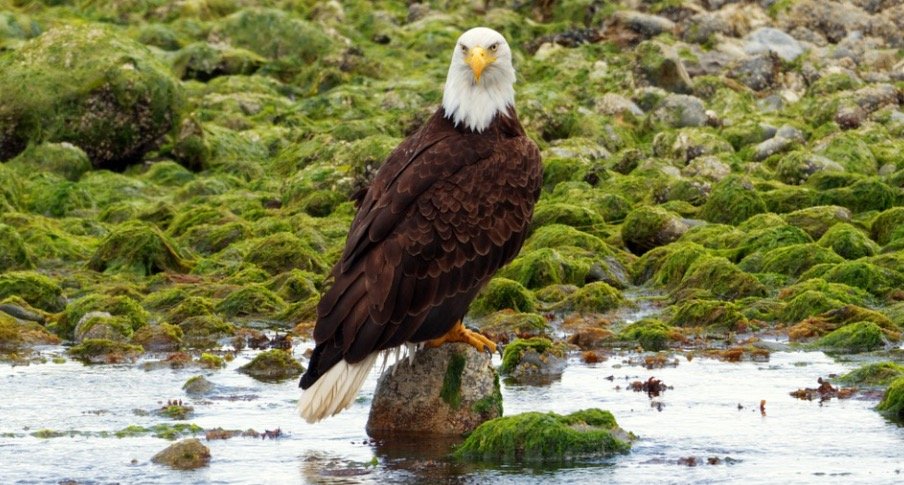
The eagle is a carnivorous creature belonging to the Animalia family, phylum Chordata, class Aves, order Falconiformes, and family Accipitridae. Its length is up to 15.7 to 39.3 inches, it weighs up to 1.1 to 15.4 pounds, and it has a wingspan of up to 27.5 to 98 inches, with a lifetime of up to 15 to 30 years.
The eagle is a bird that feeds on fish, mammals, and reptiles. The long, curved beak and strong, sharp claws are the most distinguishing characteristics.
Eagles are preyed upon by humans, hawks, and raccoons. Physical features include grey, brown, yellow, black, and white skin colorations, and feathers on the skin, with a top speed of 100 mph.
Eagle Description
The sharp-eyed eagle is one of the animal kingdom’s most dangerous predators. Eagles, sometimes known as the “lord of all birds,” are enormously strong birds of prey that fly majestically through the skies in pursuit of their next meal.
Although it is not the most graceful flier, its incredible speed in the air belies its massive bulk in comparison to other birds. The majority of species are well-protected by governments, conservation groups, and international acts all around the world, but a few of the more esoteric species are in jeopardy.
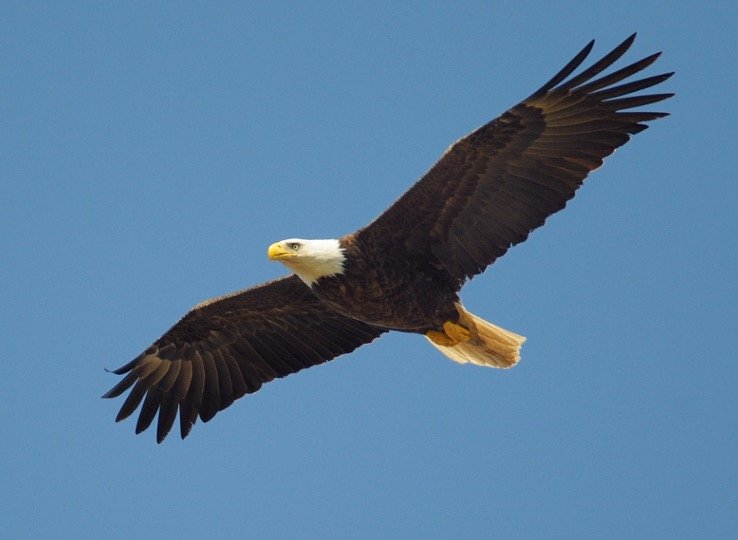
These birds may be found in practically every sort of environment on the planet, from the far northern tundra to tropical jungles and deserts. Only the bald and golden eagles are found in North America, whereas nine species are found only in Central and South America.
The Eastern Hemisphere, notably Africa, has the highest concentration of them. Most of the other islands scattered across the Indian and Pacific Oceans have their own unique species. The majority, but not all, of the world’s species appear to be in good health.
The IUCN Red List classifies the bald eagle as a species of least concern, with an estimated population of more than 100,000 individuals. This is a significant improvement from the 1980s and 1990s, when it was still listed as an endangered species.
With over 100,000 individuals left, the golden eagle is also a species of least concern. On the other hand, the harpy eagle of Central and South America is endangered and declining. The Central Asian steppe eagle is also in decline.
The IUCN Red List lists it as an endangered species, despite the fact that there are 50,000 to 75,000 adults left. In American zoos, the bald eagle is one of the most renowned attractions.
San Diego Zoo, Smithsonian National Zoo, Lincoln Park Zoo, Detroit Zoo, Oregon Zoo, Louisville Zoo, Minnesota Zoo, Denver Zoo, Tulsa Zoo, Cincinnati Zoo, Houston Zoo, San Francisco Zoo, and many other zoos have it. There are also golden eagles, crowned eagles, Steller’s sea eagles, and harpy eagles at the San Diego Zoo, as well as many other zoos.

Fun Facts About Eagle!
• Eagles are said to have descended from kites 36 million years ago.
• In many human societies, the eagle has functioned as a symbol of strength and power. They’ve appeared on the flags of Rome/Byzantium, Russia, and a number of Germanic nations. The unusual-looking double-headed eagle is a well-known historical motif that dates back to ancient Mesopotamia.
• The bald eagle’s grasp is ten times stronger than that of a human.
• Despite their significantly lower weights, an eagle’s eye is nearly the same size as a human eye.
• Every year, eagles go through a process called moulting, in which they progressively lose their feathers one by one and develop fully new ones. To maintain the correct balance, certain species will shed feathers equally on both sides.
• Eagles can carry up to four times their own weight, making them one of the world’s most powerful birds.
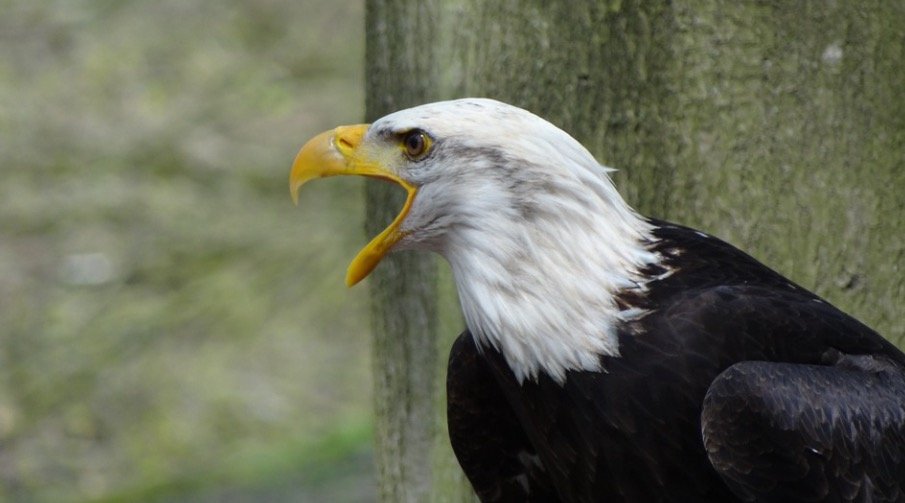
Various Eagle Species
An eagle is a huge bird that belongs to the Accipitridae family. The scientific term “eagle” comes from the Latin word “accipiter,” which means “hawk.” Vultures, kites, and hawks are among the many species that belong to this family.
The eagle is distinguished by its enormous size and powerful beak. There are around 60 species of eagles left on the planet today. Fish eagles, serpent eagles, forest eagles, and booted eagles are the four main categories of eagles.
These are not necessarily taxonomic groupings, although they are informal. Many people in the United States are unaware that the bald eagle (Haliaeetus leucocephalus) is a kind of marine eagle.
• The bald eagle is the U.S.’s national bird. These brown-bodied birds with white heads and tails can be found near open waterbodies, where they nest in old growth trees.
• Harpy Eagles may be widely distributed in tropical rainforests in Mexico, Central America, and South America. Dark grey feathers with white abdomens, a black band across their necks, and grey feathers on their heads distinguish these birds.
• Golden Eagles may be found across Europe, Asia, North America, and areas of Northern Africa. Golden eagles are dark brown in colour with whiter wing feathers and golden napes as adults.
• Stellar’s Sea Eagles reside in northern Asia’s coastal environments. Dark bodies, white shoulders, foreheads, tails, and thighs, and brilliant yellow bills distinguish these birds.
• White-tailed eagles are found in northern Europe and northern Asia, and they prefer to dwell near open water. Their bodies are dark, with light heads and necks, and white tail feathers.
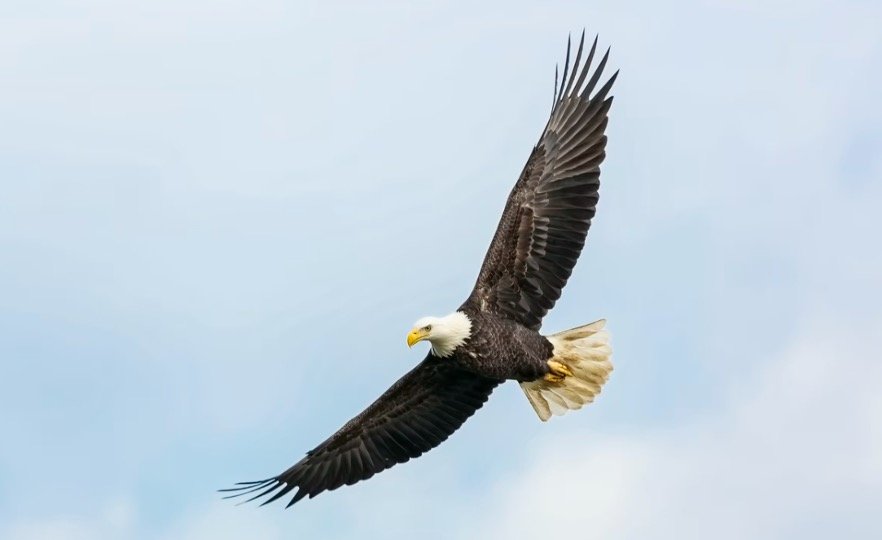
Eagle Appearance and Behavior
The eagle is one of the biggest birds on the planet; only condors and vultures come close to matching its size. The biggest eagles, including the harpy eagle and Steller’s sea eagle, may weigh up to 20 pounds and have a wingspan of 7 to 8 feet from tip to tip.
Although the reason for this is unknown, it is possible that it is done to protect the chicks from danger while the male is away.The eagles are recognisable by their sharp, hefty beaks that finish in a downward-sloping tip, as well as by their four large talons on each foot.
To grab prey, they have tiny projections on the bottom of their feet called “spicules.” Eagles, unlike the scavenging vulture, have a completely feathered head, which is occasionally topped with a luxurious-looking crest.
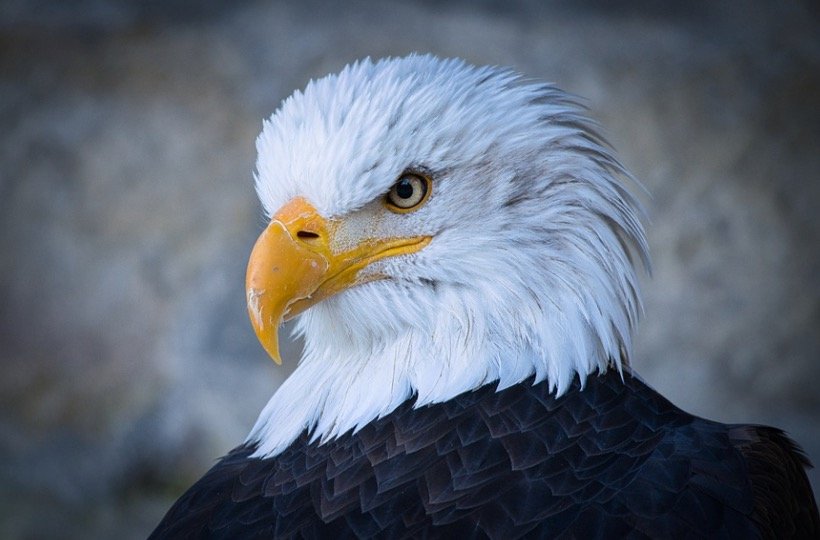
Eagles vs Hawks
The behaviour and physical qualities of eagles and hawks are very similar. Due to their combined intermediate traits, 15 species have been dubbed hawk-eagles. Hawks, on the other hand, are significantly smaller, with wingspans seldom exceeding 5 feet. These birds have extraordinary vision, which places them at the top of the animal kingdom.
It would have a 20/5 or even a 20/4 vision if translated into human terms. The size of the pupils, the number of light-detecting cells in the retina, and the shape of the fovea, a tiny hole at the rear of the eye that is crucial for an animal’s acute central vision, are all causes of this.
This provides significant aesthetic benefits. To begin with, an eagle’s vision is four to eight times that of a human, allowing it to identify tiny prey from up to two miles away, even when in flight.
Second, it can perceive a broader spectrum of hues, including ultraviolet. Finally, it has the ability to instantly adjust focus in order to zoom in on prey. However, in order for the eagle to focus on a single place, it must normally swivel its entire head in that direction. Thankfully, the eagle’s neck has 14 vertebrae compared to only seven for humans, allowing it to rotate to a greater degree.
When the bird eventually discovers prey, it generally swoops down and catches the unwary victim in its talons and feet. It moves at a breakneck speed in this activity.
The common golden eagle can plunge down at rates of 150 to 200 miles per hour, which is nearly as fast as the world’s fastest animal, the peregrine falcon. The golden eagle can only fly at 28 to 32 miles per hour in flight, yet this allows it to traverse a large portion of its hunting territory in a single day.
Although the majority of these birds are stationary, meaning they stay in the same area all year, a few species and subspecies may migrate in part or completely during the harsh winter months.A convocation, congregation, or aerie occurs when multiple eagles congregate in a group.
These birds, on the other hand, are not fond of huge social gatherings. Instead, it prefers to have a small family with a single partner and their chicks. Apart from that, it has a few other social links.
Many eagles don’t make many sounds unless during the nesting season. One exception is the bald eagle. It makes a shrill cry to communicate with one another or to warn intruders away.
What Do Eagles Eat?
In every environment where they live, these birds are the top predators. The anatomy of these birds reflects this: they have a strong beak and talons that are especially built for ripping and shredding flesh.
It is also not averse to foraging for food left behind by other animals or killed by them. In reality, the bald eagle’s proclivity for stealing the kills of other birds caused Benjamin Franklin to call it a bird of “poor moral character,” although, according to popular opinion, he did not suggest the turkey as the country’s national symbol.
These birds are also known as “feast or famine birds” since they may go weeks without eating. Check out our “What Do Eagles Consume” page for a detailed list of what eagles eat.
The diet of these birds is mostly determined by where they dwell and what they’ve evolved to eat. Fish, crabs, snakes, amphibians, tiny birds, rodents, and other animals, some as large as deer or pigs, are the most common prey.
These birds, on the other hand, rarely commit to a particular sort of diet. Despite having a particular favourite, they will consume a broad variety of different meals depending on what is available at the time. If the meal is too big for the bird’s talons to carry, it will be eaten just where the animal was killed.
Crane: Description, Habitat, & Fun Facts
Eagle Predators and Threats
These birds have historically encountered little danger in the wild until the 19th and 20th centuries. However, the combined effects of overhunting, habitat loss, and pesticide usage that contaminated the environment and water threatened the extinction of numerous species.
Eagle populations are rapidly rebounding in areas where hunting and pesticide usage are strictly managed. In the outdoors, an adult has no natural predators. Hawks, owls, raccoons, bobcats, and other carnivorous creatures may feed on eggs and chicks.
Eagle Reproduction, Babies, and Lifespan
These birds create extraordinarily strong bond pairs that mate for life after a short courting presentation that can involve an outstanding aerial performance and coordinated behaviour. This permits them to establish the same nest year after year, generally in a high and difficult-to-reach cliff or tree.
Sticks, moss, lichens, and other plant material are typically used to construct these nests, which are also known as eyries. Most of these birds, although, only utilise the nest when they are actually rearing their young and then abandon it for the remainder of the year.
The female incubates her eggs for a month or two after she lays them, while the father hunts and supplies the majority of the food. These birds can lay anywhere from one to four eggs, but the dominant, bigger chick may kill or outcompete the smaller one.
While this may appear harsh, it is a successful approach for ensuring that at least one chick survives, especially when death rates among the young are already extremely high. They normally develop their flight feathers after a few months, but due to their protracted maturation periods, it might take three or four years for them to reach adulthood.
In the wild, the normal species has a life expectancy of 20 to 30 years. The bird loses part of its hunting ability as it gets older. These birds may live to be approximately 50 years old in captivity, where they are constantly assured of food.







